Puno, which had universally been described as a "hole" to us, proved to be a pleasant surprise. After arrving without incident we checked into an upmarket hostel and decided on a day of R&R before going out to see Lake Titicaca. We spent the following day eating lots of chicen and rice, and wandering around the handicraft markets where alpaca products abounded at very low prices.
The next day the antibiotics seemed to be working their magic as we boarded a boat to take us on a tour of the nearby islands of the lake. Titicaca is the highest navigable lake in the world and is huge - a freshwater sea more or less, almost 300m deep in places. In the past it has been a key resource in the empires of Tiwanaku and Incas, the latter culture claiming an island on the lake as their "birthplace" in their creation history.
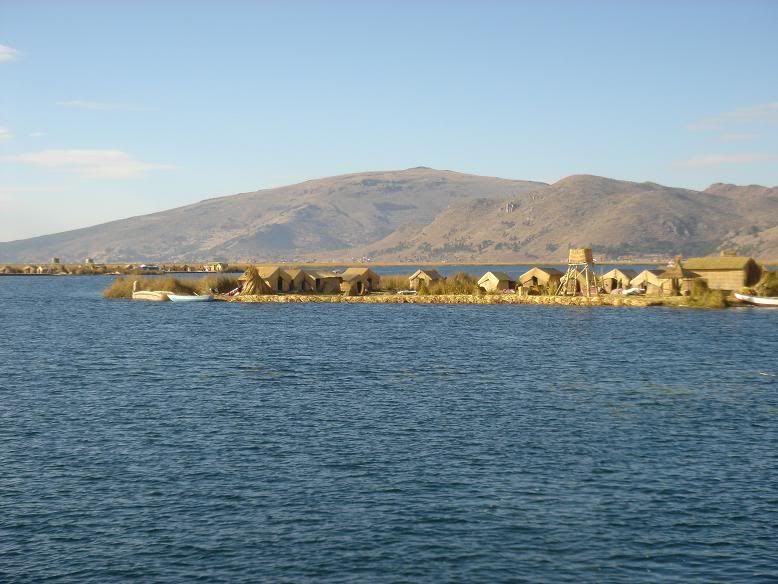
Reed Islands
Close to Puno lie the amazing floating islands of Los Uros. The islands, constructed of floating mats of reeds, can exist for up to 50 years before the thickness of reeds causes the islands to sink. In the past the people of these islands subsisted on fishing, but nowadays tourism is the one and only business of the islands. Despite this, the islands were an extremely interesting place to visit - our guide was unusually informative about life on the islands and around Titicaca. After visiting a couple of islands and taking a ride on a traditional reed boat we headed on to the island of Taquile, some 2 and a half hours away in the main part of the lake.
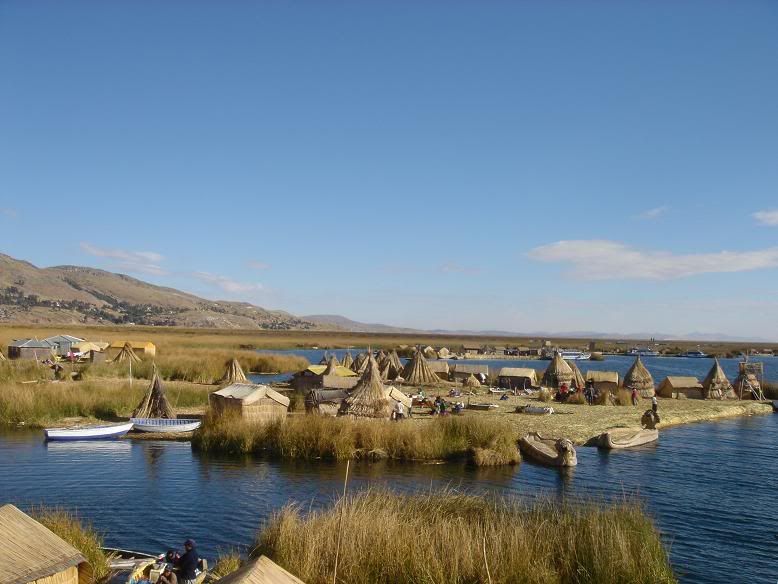
And more reed islands
Taquile is another heavily touristed island, but of the 2000 inhabitants there are some that still rely on traditional agriculture in amongst the restauranters, weavers and friendship bracelet and wooly hat sellers. We walked across the island to the small town at it's centre (packed full of gringos) then onto a small restaurant for a late lunch. Our guide gave us an interesting talk on local customs - the single men here (identified by their hats) being far more forward than the women, this being a contrast to the neighbouring island 1 hour away, where the men are shy and retiring and the women..... well. Despite the feeling that it was all a little contrived we had a nice time and learnt a lot more than we would have done by ourselves, and Taquile had policies in place that made sure that tourist money brought onto the island stayed on the island, which is always nice.
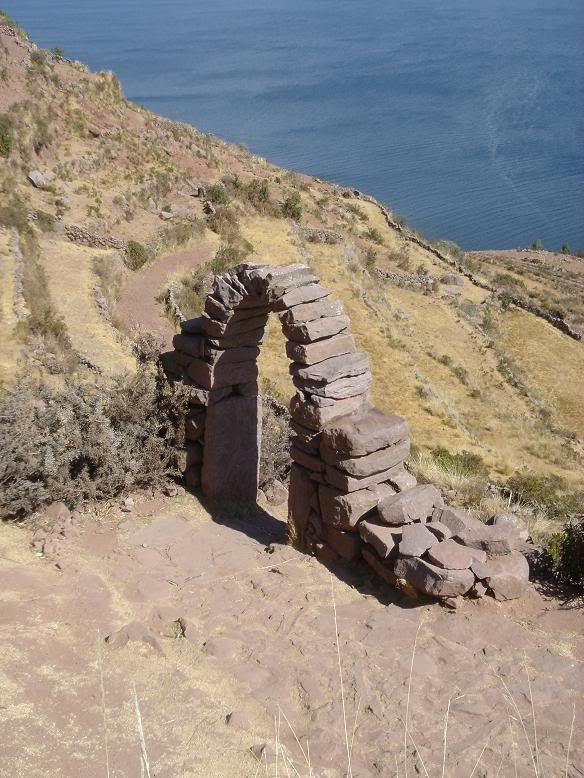
Taquile Island
We took the long, cold and slow boat ride back, sitting on top of the warm exhaust and arriving back in Puno at dusk. After an excellent pizza we turned in early for our bus to La Paz, Bolivia, the following day.
The bus to Boliva was a gringo-only affair, and we quickly made our way down the western Titicaca shore before crossing onto the peninsula that divides the lake into it's larger northern and smaller southern portions. Here we also crossed into Bolivia, arriving in the very pleasant shore town of Copacobana. We had a couple of hours to relax, take in the laid back atmosphere and eat a leisurely lunch. We returned to our bus and found it departed 1 hour before - we had forgotten the time difference.
Fortunately we were still in possession of all our bags so we boarded a local bus to La Paz, which for 5 hours slowly wound it's way across dirt tracks and highway until coming to the de facto captial of Bolivia. La Paz sits in a wide canyon cut into the altiplano, surrounded by El Alto, the suburban overspill high up above the city centre. We arrived in the dark and made our way to a hostel recommended for it's excellent hot showers - always important when you're at 3600m.
With only a limited time in Bolivia, we planned everything as carefully as we could. That night, in a "100% fake English pub" (excellent steaks) we decided on our priorities - visiting the jungle at Rurrenbaque, visiting the salt flats around Uyuni, and cycling the "Death Road" from La Paz to Coroico. We did, however, need a day looking around La Paz when we could also book the flights and tours required for our plans.
La Paz has lost most of it's colonial architecture except for a few old churches and palaces, and modern tower blocks and Burger Kings jostle for position amongst the low rise drab concrete buildings that make up the most of the city. We spent a pleasant day sounvenir shopping, and buying flight tickets to Rurrenabaque for a couple of days time, and arranging the "Death Road" biking trip and a tour to Tiawanku, a nearby ancient city.
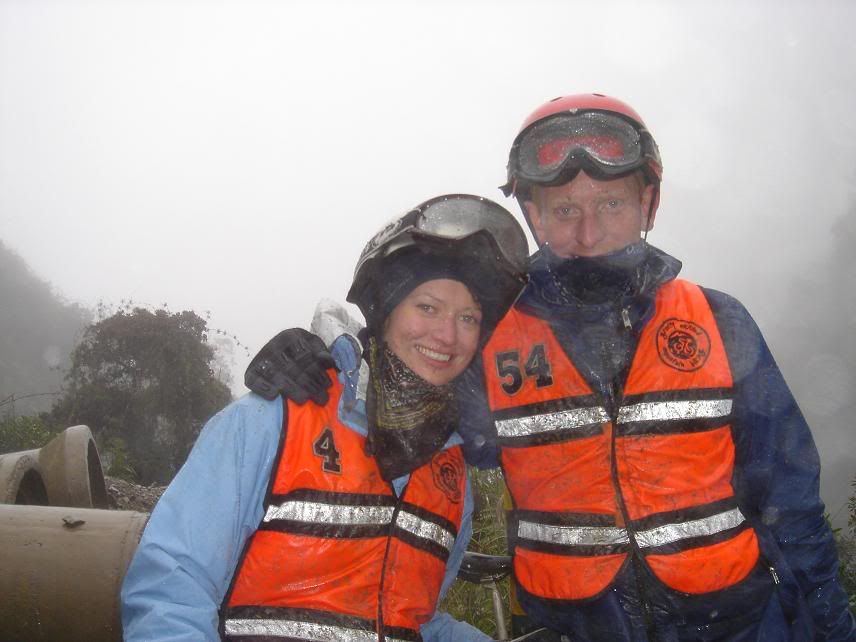
At the top of the Death Road
The following day we met up early at Gravity Assisted Biking, to make the famous 3600m descent over 72km down the deadliest road in the world - an average of one vehicle a week plunges off the sheer cliffs that range from 100 to 1000m in height (they haven't heard of crash barriers here). The first 25km were a delight - high speed on tarmac, great views, sunny - if a little cold. Then we entered the cloud and rain, and reached the end of the tarmac.
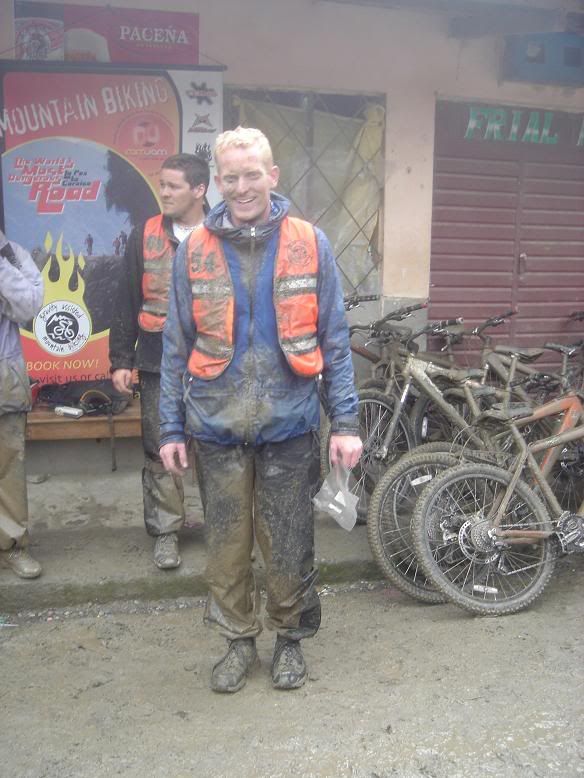
At the bottom, wanting a shower
The following 3 hours of downhill was very wet and very muddy. We missed out the the fear factor usually present as the drop offs were obscured by cloud, but it was enough in certain places just to see the edge of the road disappear into nothingness. In the past 5 years 8 cyclists have died on the road, "but never with this company" as our guide regularly informed us, before regailing us with stories of failed brakes, poor steering and sheer bad luck. We reached the bottom soaked to the skin and not a little muddy, and we well pleased to climb on the bus up to Coroico where hot showers and lunch awaited us. Probably the scariest aspect of the day was the ascent back up to La Paz - 4 hours climbing the road we had descended, meeting huge trucks in the pitch black on a dirt road, slick with mud, barely wider than your driveway.
The following day we went to Tiwanaku - a cultural experience miles away from the previous day. Tiwanaku was the centre of a theocratic state that preceded the Incan empire by several centuries. It relied on Lake Titicaca as the basis of it's agriculture, and it is theorised that the state failed when the waters of Titicaca receded to it's present day shores. The priest-rulers of the state based their religion around worship of the sun and the many aspects of the Tiwanaku site reflect this. The huge stone monoliths demonstrate skilled stonemasonry that the Incas are also famous for - in fact, many aspects of both Incan religion and masonry are borrowed form the Tiwanaku culture.
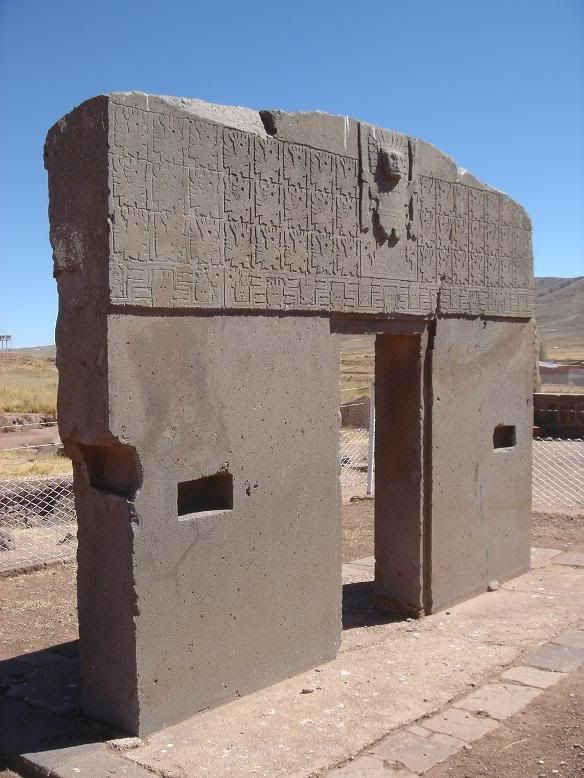
A Sun Gate
En route to Tiwanaku we stopped at the original site of La Paz - founded on the altiplano as a control point for the huge amounts of silver that were being mined further south in Potosi and enriching the Spanish empire. There was a beautiful cathedral,built mainly of old Tiwanaku stone and on top of an old temple; it never fails to depress me how ancient cultures have been systematically eradicated in the name of religion. We moved onto Tiwanaku and looked around the museum, being given a somewhat rushed introduction by our guide before preceding to the main temple complex.
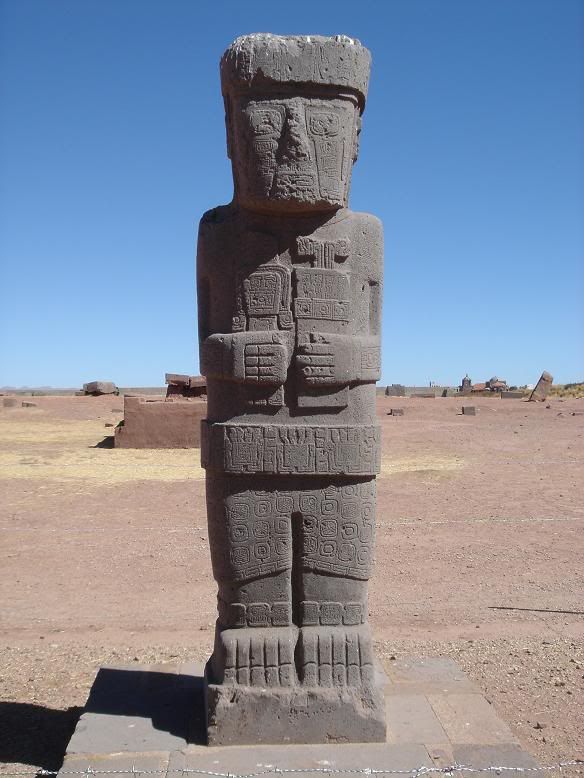
This was really impressive. There were originally a series of "sun gates", aligned with the sunrise on the summer solstice, and the enitre temple was laid out as a solar clock such that the sun would rise over a certain monolith depending on the time of year, when viewed from one of the sun gates. There was also a huge step pyramid - now almost unrecognisable having been excavated by the conquistadores in an attempt to find non-existent buried treasure. There was a subterranean temple, excellently restored, in front of the main solar clock temple, with an eerie array of stone faces set into the rock.
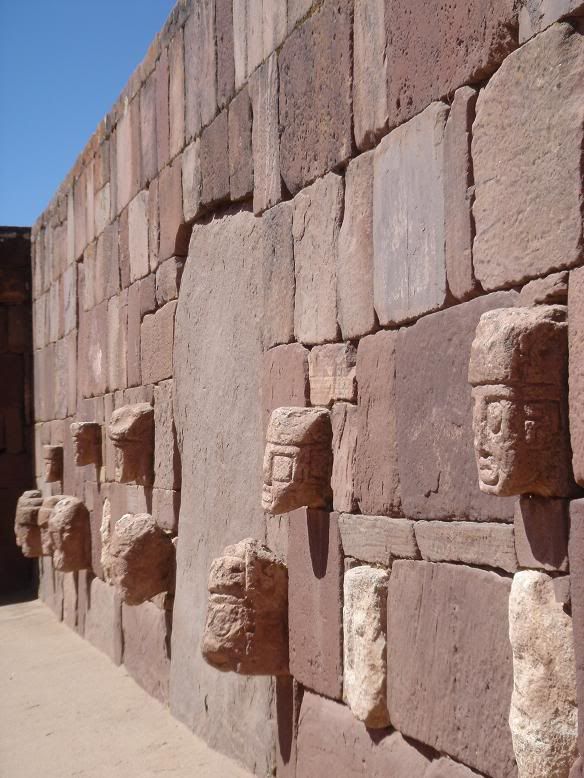
Subterranean temple
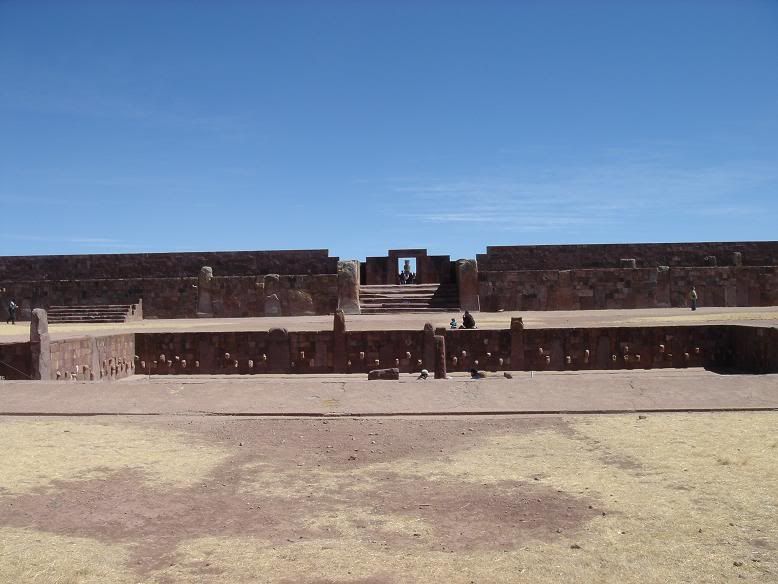
Summer solstice Sun Gate
The following day we were due to fly to Rurrenabaque - centre for all things jungle and panatal related in Bolivia. We arrived at the Military airbase on the outskirts of La Paz at 10am in good time to catch our TAM flight, only to be told that the 12.30 flight has been delayed until 15.00. We decided that rather than wasting time we would go back into La Paz and book a tour of the Pampas rather than having to rush around and find one when we arrived in Rurrenbaque. Having been recommended a tour agency we went straight to their office and booked a 3 day, 2 night tour.
We returned to the airport at 15.00 to find that our flight was still delayed, so we took the time to get to know our fellow passengers. At 17.00 the plane was ready to be boarded, we checked our bags in and got our hand luggage searched and waited in the departures lounge, until an important looking man in uniform came out and announced that the flight was going to be delayed until the following day as the plane would not be able to land at the Rurrnebaque airport as it would be dark and there is no lights there. By this stage a number of other passengers got quite irate, but the important looking man smoothed things over, promising the flight would leave at 7am the following day and he would arrange a free bus into La Paz and a pick up in the morning. So we all went back into La Paz and we checked back into the hostel we had left that morning.
The next day we got up at 5.30 in time to meet the bus at 6am, we arrived at the airport and things were going well. We all checked our bags in, got our boarding passes, got on the plane and started taxing to the runway. Then came the announcement that the plane still had mechanical problems and was returning to the hanger, we were all lead back to the departures lounge. The passengers who had got upset yesterday really began to loose the plot now, demanding their money back and trying to arrange a bus to Rurrenbaque instead, the problem with getting the bus however, it is that it take 16 hours down unpaved, bumpy tracks which includes going downhill on the ‘World’s most dangerous road’. Pete and I decided we would rather take our chances with the plane.
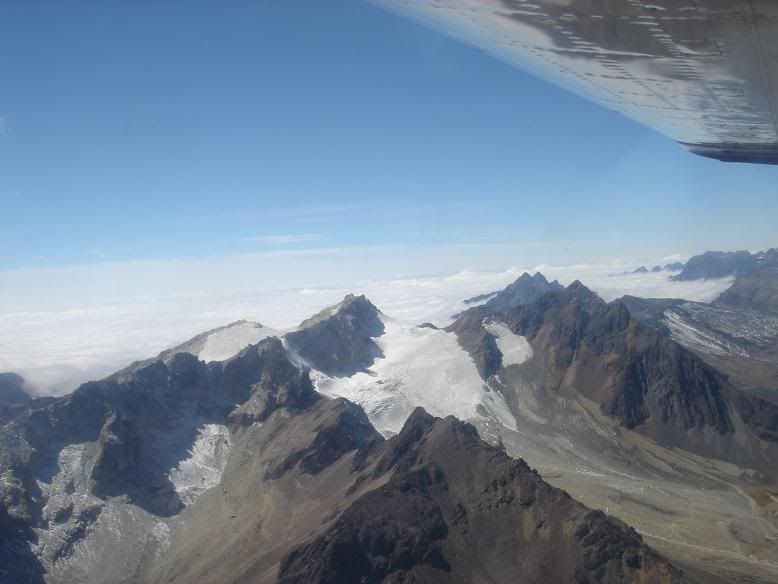
Crossing the Cordillera, en route to Rurrenabaque
After a long morning of hanging around with no straight answer of when or if the plane was going to depart, a Slovakian couple had got in touch with their tour agency who said they could organise a private charter of a plane to Rurrenbaque for only 5 dollars more than the cost of the TAM ticket, if they could find another couple. This was an opportunity we couldn´t refuse. So in a very rock n’ roll way we chartered our very own private plane, which took off at 12.45. The flight was amazing, flying over the dry barren altiplano, between the mountains, then looking down on the changes of ecosystems, as the land turned from white, to green which accumulated in flying over the rainforest, which was a sea of rich green punctuated occasionally by tree with bright yellow blossom.
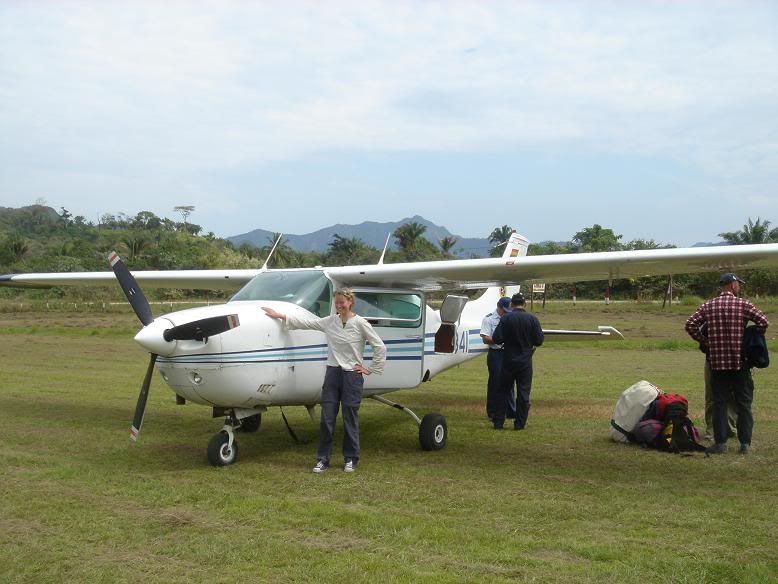
Our plane
We smoothly touched down in Rurrenbaque an hour later, to find a humid tropical climate. We then got a taxi – which had been self-converted from a right-hand drive care to left-hand by its owner. We checked into a pleasant hostel on the edge of town and went for a wander, we bumped into some of our fellow passengers from the TAM flight, which had eventually taken off at 13.30.
The next morning we arrived at 8.30 at our tour operator´s office along with about 25 others to start our three day trip into the Pampas. Fortunately we were divided into groups and we were with 5 others, 2 Austrailians, 2 Belgians and an English guy. Everyone else left and we awaited for our 4x4 to arrive. Eventually this huge Chevrolet, Suburban (called suburban, because it could fit a suburb in it) we piled in the back of it and set off. The ride was long bumpy and dusty – by the end of it we looked like we had all got very cheap fake tans. The ride was made more exciting by getting a blow out, but we were treated to lots of wildlife sightings from the ride, including spotting a sloth in the top of a tree.
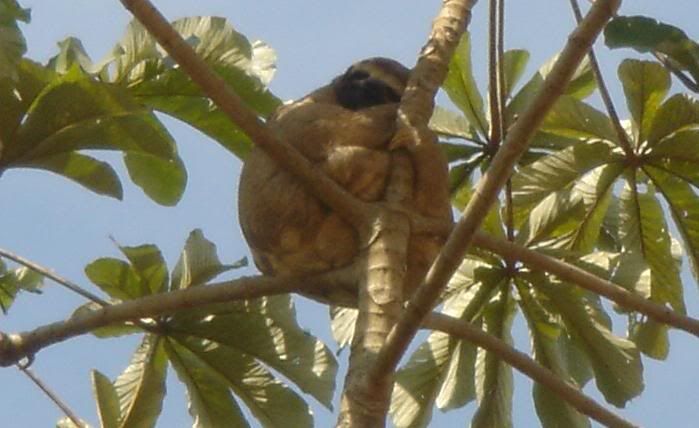
Sloth
We arrived in a small village on the edge of the Tuschi river where we were to get canoes to our campsite. Clearly the pink river dolphins had been briefed of our arrival as they put on a good show just meters away from where we sat on the river bank. Wilson, our guide, arrived and we loaded up the canoe and set off down the river. Taking in wildlife as we went including, a huge bird called a Jaberoo, turtles, crocodiles, caiman, herons, kingfishers, vultures, eagles, egrets, a hotsill (a bird that doesn’t look to dissimilar to a pheasant), capybara (the world´s biggest rodent, which basically looks like a giant guinea pig), tucans, macaws, yellow monkeys and red howler monkeys.
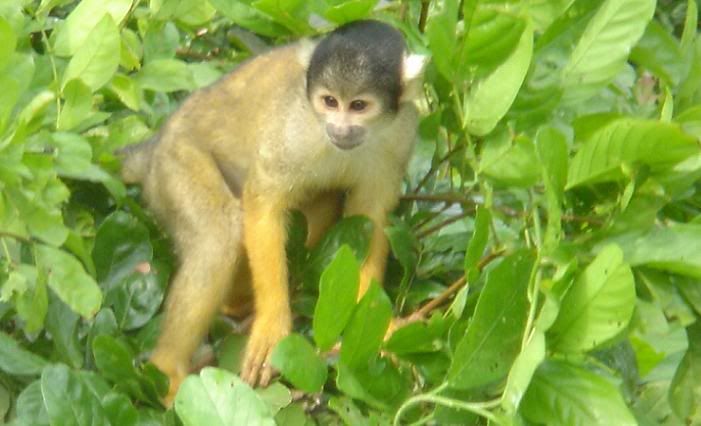
Yellow Monkey
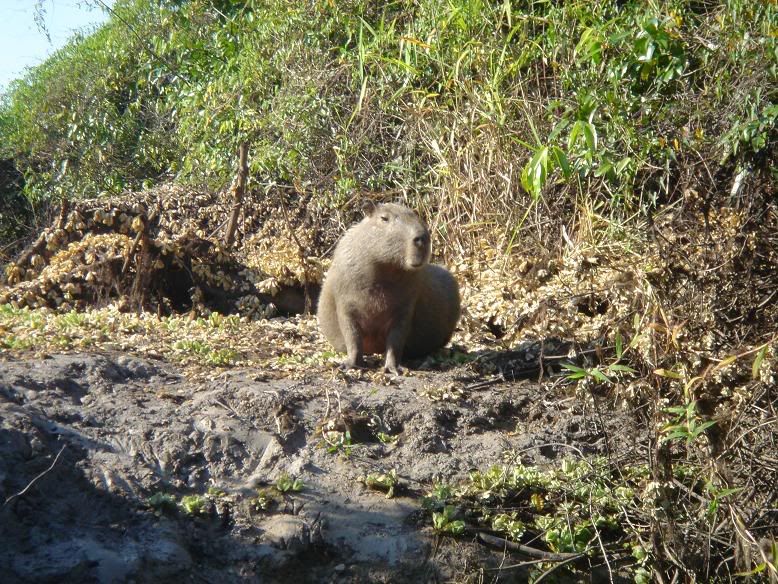
Capybara
After 3 hours we reached camp, to find that a pet crocodile had moved in, Pete decided to make friends. After a cup of tea, we set back off in the canoe to the Sunset bar, to drink beers and watch the sunset. Feeling relaxed, although slightly eaten by mosquitoes we returned to camp for dinner and bed.
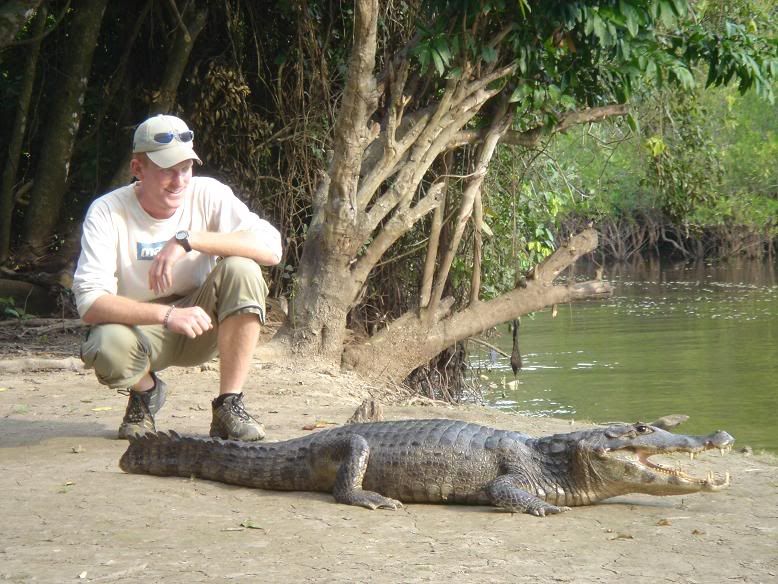
Middle name, "Dundee"
The next day we had a huge breakfast, our group priding ourselves on eating all the food, including the other groups left-overs and then set off by foot across the boggy pampas in search of anacondas. Not expecting to find any, especially as all 25 of us were stomping about, within an hour one of the guides had caught a small one, about 60cm long, after a brief explanation about their natural history the poor unsuspecting Anaconda was gently returned to the cool wet mud a slipped off. We carried on a bit further, when with great excitement another guide pounced and caught a much bigger snake, 2m long. We returned to camp for lunch and a siesta.

Anaconda!
Later that afternoon we had to catch our supper, which was piranha. We were given pieces of meat which we hooked onto the end of fishing lines which we dangled over the side of the canoe. Despite Pete and I getting lots of nibbles from the ferocious little critters, we both failed to catch any, and in fact neither did anyone else in our group. So instead we decided to return to the Sunset Bar for more beer. A little worse for wear and loaded with extra cans of beer, we returned back to the camp where fortunately there was other food for dinner and finished off the evening around the campfire. By this stage the pet crocodile had decided to move on as we ate all the food and there were no left-overs.
The next morning we set off up the river to find pink dolphins, as if there are dolphins there are no piranhas or crocodiles and it is safe to swim, well that was what Wilson assured us. Pete was the first to jump in, being braver than most of us – maybe because in the water he didn’t look to dissimilar to a pink dolphin. After making sure Pete wasn’t being eaten, I decided that it was safe enough and jumped into the murky warm water. We returned back to the campsite where we had a very early lunch, packed up and departed back to the village where we started our trip.
After an uneventful ride back to Rurrenbaque, we relaxed for a bit and then met back up with our group for happy hour cocktails in Mosquito bar. We steered fairly clear of lots of the very good cocktails, as we had an early morning flight back to La Paz.
The following morning, and our flight was….delayed. No surprise there, but it was only a 3 hour rather than 24 hour delay. Back in La Paz, we boarded our bus to Uyuni having made it through a huge celebration in centre - apparently all the students were celebrating their entrance into University by a huge carnival-like parade in the streets. How we laughed.
Our bus was not all it was cracked up to be in the pictures, and the 14 hour journey passed overnight in freezing discomfort. We arrived early in Uyuni, in southern Bolivia, and found a hostel where we could sleep for a short while before arranging a 4 day tour the following around the very south west of Bolivia.
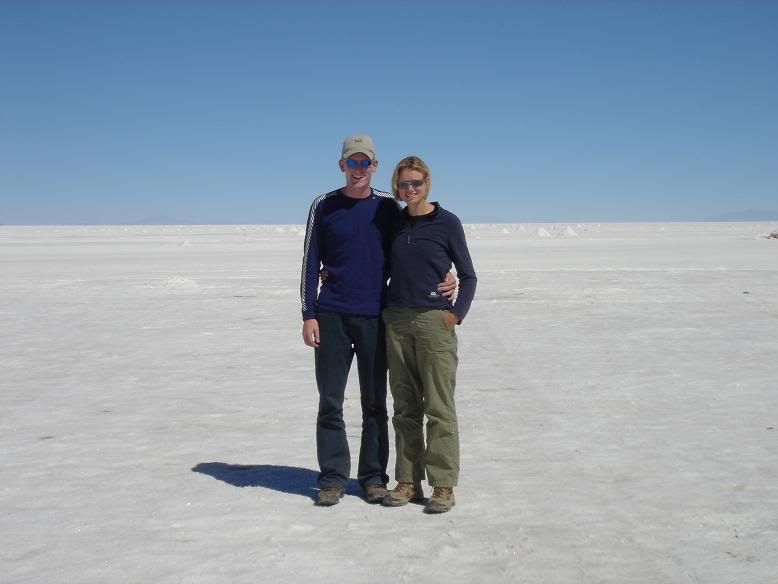
On the Salar
Uyuni is a main stop on the gringo trail for one big reason - the Salar de Uyuni. This salt flat is the largest in the world, containing as estimated 64 million tonnes of salt in a crust 2 to 2o metres thick. Driving onto the Salar is like driving onto another world - the huge white emptiness rolls out in front until the horizon; in places, hills and mountains seem to float in the distance in a shimmering mirage. We drove for a couple of hours to reach "Fish Island" - so called because of it's shape, where there has developed a unique isolated ecosystem based around giant cacti. The cacti were really impressive - the largest over 12 metres tall - but the expansive views over the salt flats where the jaw dropping. The overhead sun and biting cold removed some of the otherworldly magic, but the vastness remained, quiet and bright, stretching out in all directions.

Vast!
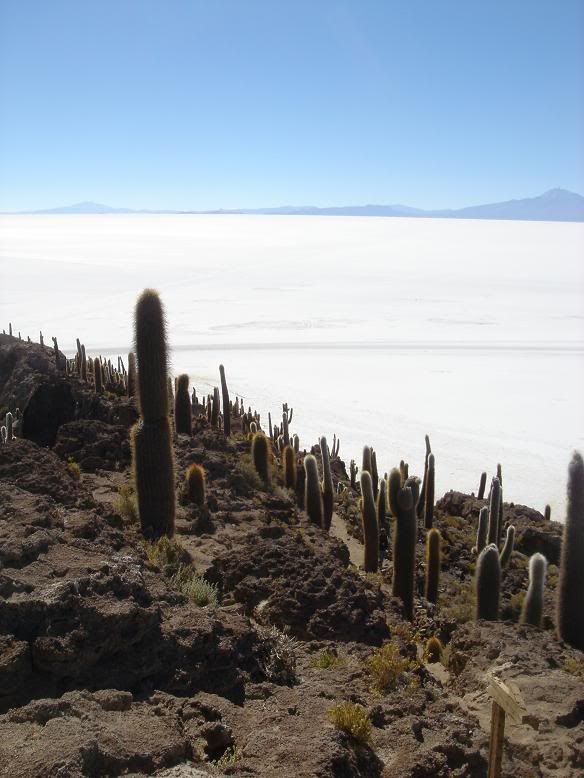
Isla del Pescado (Fish Island)

We left the Salar that afternoon to stay the night in a hotel made of blocks of salt. It was surprisingly well equipped and after visiting a local outdoor museum we ate well and slept better in a warm room.
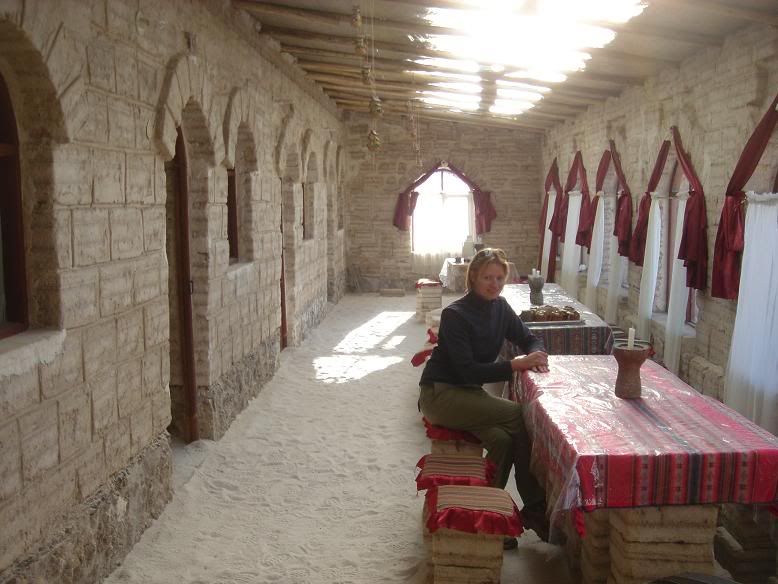
In the salt hotel
The next morning we were up early to begin the long journey to the south, passing on the way another smaller Salar, then reaching a viewpoint over an active, gently smoking volcano. The highlight of the day was reaching a series of 5 lakes, all populated with flamingos. Despite their white shores, there was no salt in the lakes - only borax. The flamingos were feeding on algae in the lakes - there is a population of around 100,000 in the region, existing on the lakes. After lunch we moved on, climbing up to 4800m and driving acrosss barren rocky desert, before dropping slightly to reach Laguna Colorada, where we were to spend our second night. This lake, named after it's pink hue, supports the majority of the flamingos in the area and the pink algae also gives the flamingos their pink colouration.
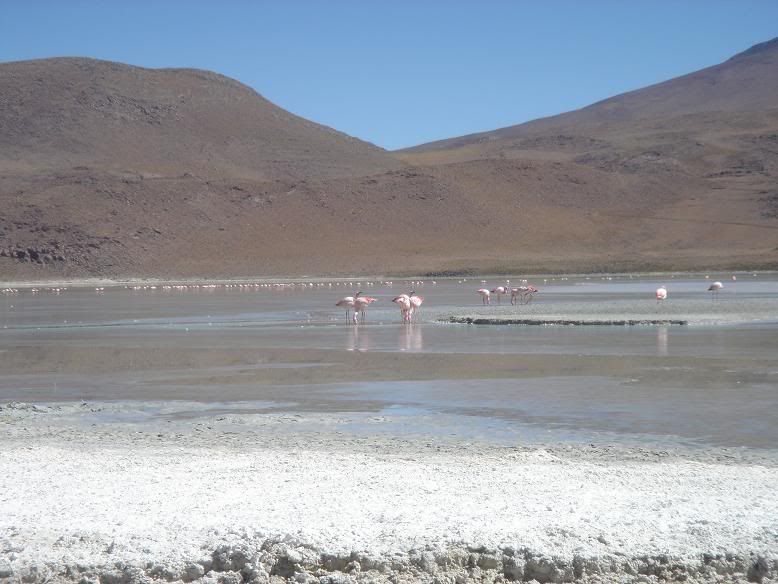
Flamingos!
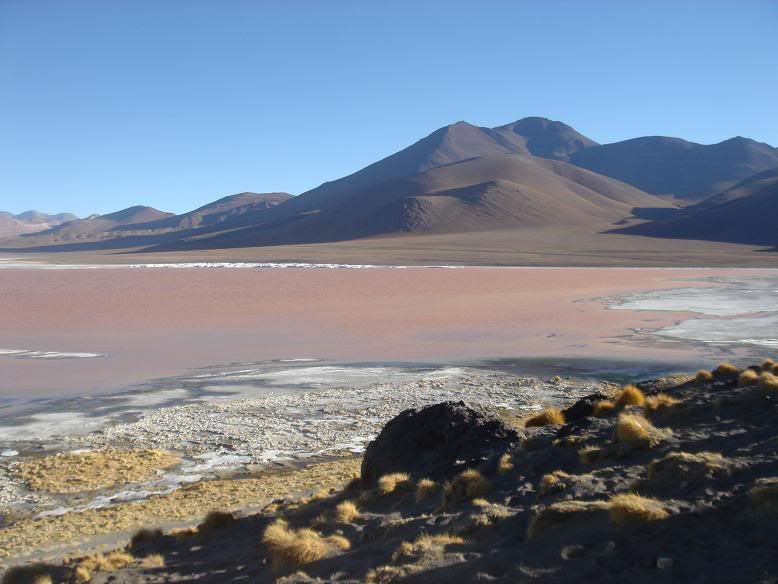
Laguna Colorada
The cold we had expcted that night - staying at 4200m - was not as bad as anticipated, nor was it too bad when we arose at 5am to reach nearby geyser fields for sunrise. Despite our fears that we would not arrive in time, we pulled up at just the right time to catch the geysers as the sun crested the hill - it was a very pretty (and smelly) sight. We moved on to another lake where there were hot springs running into a lake - to our surprise, everyone was paddling and seemed surprised when Hannah and I got changed and went for a proper bath.
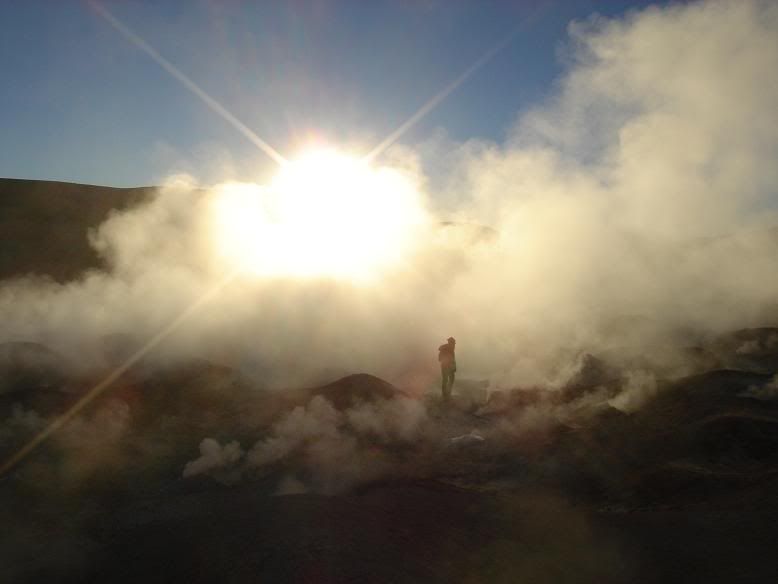
Geysers
Next stop was Laguna Verde, a lake coloured green due to various lead and aluminium sulphates in the water (no flamingos!), where we waited for a hour in the sun whilst 2 memebers of our 6 man tour were dropped off over the border to San Pedro de Atacam in Chile - the place I had enjoyed sandboarding so much back in May. That afternoon we returned to the other side of Laguna Colorada, where we had a very peaceful lunch on the quiet shores; the popularity of the Uyuni tour means that usually there are 10-15 jeeps on the same trail, but by taking 4 days rather than 3 we had lagged behind the crowd a little.

laguna Verde
We continued in a rather kangaroo fashion that afternoon - after running out of fuel, we siphoned some more in from drums on the roof only to find get some junk in the carbourettor; our skilled driver Mateo took the enigne apart in the middle of the desert on his rubber foot mat and fixed the problem whilt we looked around the Valley of Rocks, a series of wind eroded rock outcrops. We made it back to Culpina K, our village for the night, after only a couple more unplanned stops. It had been a long day and after a nice dinner we hit the sack and fell soundly asleep.
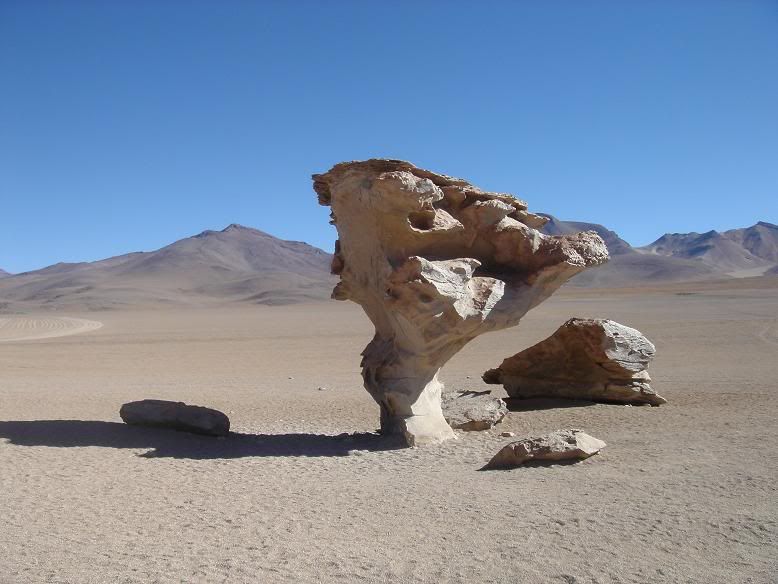
The Rock Tree - not in the Valley of Rocks, but it's close!
The following morning was our last on the tour, and we quickly arrived back in the environs of Uyuni. We stopped at the "train cemetery" for lunch - a seeming source of fascination for many tourists here. Whilst I can't help but be impressed by the remains of ancient cultures - such as Tiwanaku - there is something really ugly about huge quantities of metal being left to rust in the desert; the train cemetery to me was a vast waste dump.

Train cemetery
We got back to Uyuni and had an afternoon to relax before taking our overnight bus back to La Paz. We visited an excellent American-run pizza place - sometimes local food is too much - and burnt CDs in our free time. Our overnight bus back to La Paz - heated this time - left late but arrived earlier than expected, giving us a free day in La Paz to complete chores and eat more 100% fake English steak before we had to leave Bolivia for Cusco, Peru the following day.
Everything has been going very smoothly for a change. Cloned credit cards are now a thing of the past, buses seem to be running on time, we have a job for the winter (running a chalet in Val d'Isere), we've posted home all our souvenirs as planned, our Inca Trail booking exists and has been paid for..... it's nice! Our next post will be a while - we've got the Inca Trail to do, then a week long visit to Manu National Park (the most biodiverse region in the world), and then a 3 day rafting trip. All this plus exploring Cusco, former Incan capital and now main gringo hangout on the continent. We're loving it!

1 comment:
Hi Pete, and Hanna, I hope to meet you soon,
Enjoyed reading your latest experiences, some of which took me back to my Peruvian, Bolivian travels a couple of years ago. Sad that things are becoming more crowded on the Gringo trail, but you seem to be still finding the different things to do.
As for my news I have bought a place 14K south of Powell River on the upper Sunshine Coast, 140 k North of Vancouver (two ferries to get there..keeps the riff-raff away) I hope to be installed there on November 1. Five minutes from a white sandy beach, nice house, almost an acre of land. Decidedly uncrowded and lots of Eagles, bears and seals. Are you still planning to come to Canada? Just remember that you will always be welcome to stay with me (wherever that might be)
Miss you Pete and keep on adventuring (and you Hanna)
Ray
Post a Comment